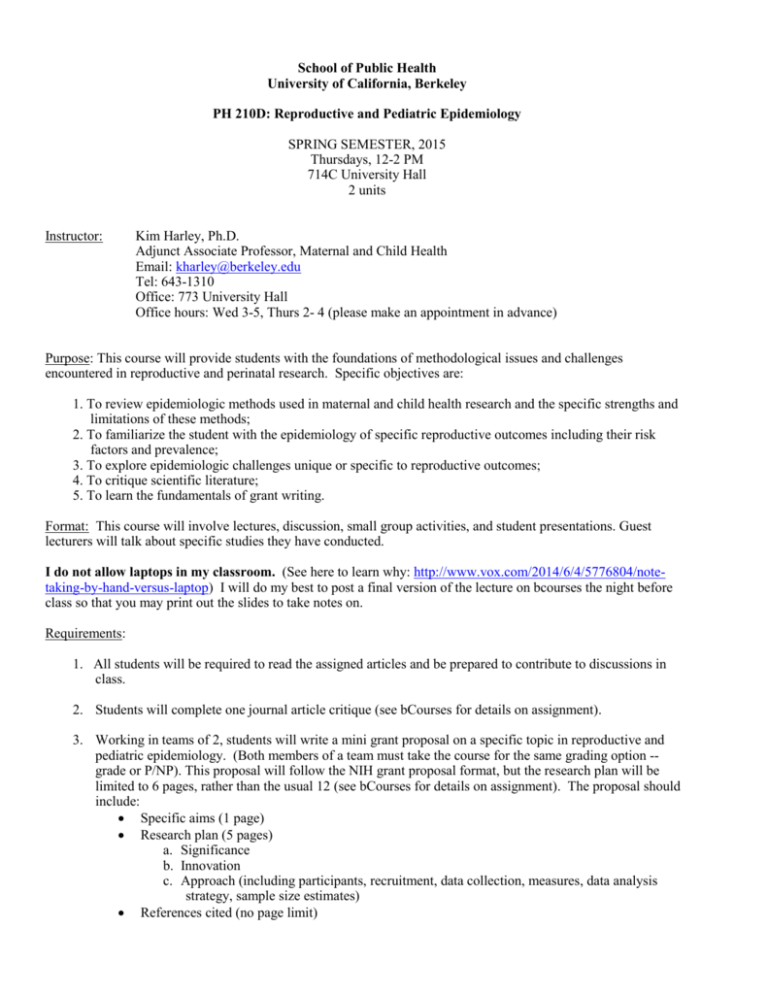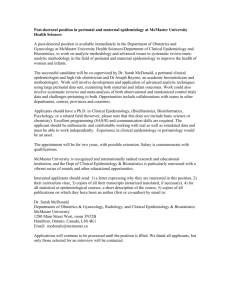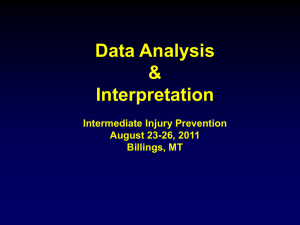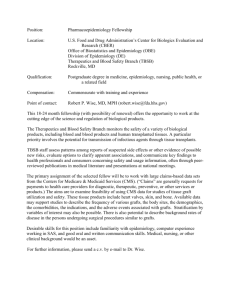Reproductive & Perinatal Epidemiology - ATMCH
advertisement

School of Public Health University of California, Berkeley PH 210D: Reproductive and Pediatric Epidemiology SPRING SEMESTER, 2015 Thursdays, 12-2 PM 714C University Hall 2 units Instructor: Kim Harley, Ph.D. Adjunct Associate Professor, Maternal and Child Health Email: kharley@berkeley.edu Tel: 643-1310 Office: 773 University Hall Office hours: Wed 3-5, Thurs 2- 4 (please make an appointment in advance) Purpose: This course will provide students with the foundations of methodological issues and challenges encountered in reproductive and perinatal research. Specific objectives are: 1. To review epidemiologic methods used in maternal and child health research and the specific strengths and limitations of these methods; 2. To familiarize the student with the epidemiology of specific reproductive outcomes including their risk factors and prevalence; 3. To explore epidemiologic challenges unique or specific to reproductive outcomes; 4. To critique scientific literature; 5. To learn the fundamentals of grant writing. Format: This course will involve lectures, discussion, small group activities, and student presentations. Guest lecturers will talk about specific studies they have conducted. I do not allow laptops in my classroom. (See here to learn why: http://www.vox.com/2014/6/4/5776804/notetaking-by-hand-versus-laptop) I will do my best to post a final version of the lecture on bcourses the night before class so that you may print out the slides to take notes on. Requirements: 1. All students will be required to read the assigned articles and be prepared to contribute to discussions in class. 2. Students will complete one journal article critique (see bCourses for details on assignment). 3. Working in teams of 2, students will write a mini grant proposal on a specific topic in reproductive and pediatric epidemiology. (Both members of a team must take the course for the same grading option -grade or P/NP). This proposal will follow the NIH grant proposal format, but the research plan will be limited to 6 pages, rather than the usual 12 (see bCourses for details on assignment). The proposal should include: Specific aims (1 page) Research plan (5 pages) a. Significance b. Innovation c. Approach (including participants, recruitment, data collection, measures, data analysis strategy, sample size estimates) References cited (no page limit) Protection of Human subjects (1 page) Budget and budget justification (optional, 1-2 pages) 4. Each team will have 20 minutes to present their grant proposal to the class, as if to an NIH Study Section. The presentation will consist of: Background information on the topic and a review of the literature. (5 minutes, first partner). A literature review table will be handed to the professor at the beginning of the presentation. (See bCourses for a sample literature review table.) A description of the specific aims and methods (5 minutes, second partner) Please discuss the methods you propose to use to address the question and questions and difficulties you anticipate. A discussion of the strengths, weaknesses, and challenges of the proposal (10 minutes, entire class) One copy of the presentation (handout, six slides per page) will be provided to the professor. Grant proposals will be due one week after the presentation (i.e. on the last day of class for teams presenting the previous week and on the Thursday of reading week for teams presenting on the last day of class). Grading: Class participation Journal article critique Literature review table Final presentation Final paper (grant proposal) 20% 10% 10% 20% 40% Required Reading: I have divided the reading into two categories: required and recommended. You must read the 1-2 required articles before class and be prepared to discuss them. You are highly encouraged to also read the recommended articles, which are seminal, theoretical articles in the field of reproductive epi and will be reviewed in the class lecture. Weekly readings are posted on the course website at http://bcourses.berkeley.edu. Required readings are marked with an asterisk (*). Additional resources: 1) Wilcox AJ. Fertility and Pregnancy: An Epidemiological Perspective. Oxford University Press. 1st Edition. 2010. (Available for loan online through the UC Berkeley library) 2) Adams MM. Perinatal Epidemiology for Public Health Practice. Springer, 2nd Edition. 2009. (Available for download online through the UC Berkeley library) 3) Louis GMB. Reproductive and Perinatal Epidemiology. Oxford University Press. 2011. 4) Sheiner E. Textbook of Perinatal Epidemiology. Nova Science Publishers. 2010. 5) Kline J. Conception to Birth: Epidemiology of Prenatal Development. Oxford University Press, New York, 1989. 6) Kiely M. Reproductive and Perinatal Epidemiology. CRC Press, 1991. 7) Källén B. Epidemiology of Human Reproduction. CRC Press, 1988. Date Instructor Topic 1/22 Harley Introduction to reproductive epi 1/29 Harley Ethical issues in reproductive epidemiology Readings Recommended: 1) Hogue CJR et al. An introduction to epidemiologic methods. 2) Savitz et al. Epidemiologic Measures of the course and outcome of pregnancy. 3) Weinberg, CR and Wilcox AJ “Methodological Issues in Reproductive Epidemiology” in: Rothman K, Greenland S, Lash TL. (eds). Modern Epidemiology (third edition). Required: 1) *Birmingham and Doyle. Ethics and governance of a longitudinal birth cohort. Recommended: 2) American College of Epidemiology Ethics Guidelines 2/5 2/12 Harley Harley Fertility Spontaneous abortion and early fetal loss Assignment: Journal article critique due 2/19 2/26 Sandra McCoy, PhD Contraception and STIs Harley Fetal Growth and Birth Weight Assignment: Hand in 3 possible topics for your grant proposal. Assignment: With your partner, hand in 3 possible research questions for your grant proposal Required: 1) *Stephen and Chandra. Declining estimates of infertility in the United States: 1982-2002. 2) *Thoma et al. Prevalence of infertility in the United States as estimated by the current duration approach and a traditional constructed approach Recommended: 3) Joffee M et al. Studying time to pregnancy by use of a retrospective design. Required (review one for journal article critique) 1) *Fenster et al. Caffeine consumption during pregnancy and spontaneous abortion. 2) *Savitz et al. Caffeine and miscarriage risk. Recommended: 3) Wilcox et al. Incidence of early loss of pregnancy. Required: 1) *Ahmed et al. Risks and benefits of lifelong antiretroviral treatment for pregnant and breastfeeding women: a review of the evidence for the Option B+ approach 2) *McCoy et al. Unmet need for family planning, contraceptive failure, and unintended pregnancy among HIV-infected and HIV-uninfected women in Zimbabwe 3) * Ralph et al. Comment: Next steps for research on hormonal contraception and HIV Required: 1) *Barker DJP. Fetal origins of coronary heart disease. 2) *Wilcox A. On the importance – and the unimportance – of birth weight. Recommended: 3) Collins JW and Shay DK. Prevalence of low birth weight among Hispanic infants with United States-born and Foreignborn mothers: the effect of urban poverty. 4) Zambrana et al. Prenatal health behaviors and psychosocial risk factors in pregnant women of Mexican origin: the role of acculturation. 3/5 Harley Pregnancy Complications and Preterm Birth Assignment: Letter of intent for grant proposal due 3/12 3/19 Nina Holland, PhD Harley Epigenetics Male Reproductive Health Assignment: Specific aims page of grant proposal due Required: 1) *Weinberg CR. Toward a clearer definition of confounding. 2) *Howards et al. “Toward a clearer definition of confounding” revisited with Directed Acyclic Graphs. Recommended: 3) Muglia and Katz. The enigma of spontaneous preterm birth 4) Greenland et al. Causal diagrams for epidemiologic research Required: 1) *Perera and Herbstman. Prenatal environmental exposures, epigenetics, and disease 2) *Heindel and Vandenberg. Developmental origins of health and disease: a paradigm for understanding disease cause and prevention Recommended: 3) Tammen et al. Epigenetics: The link between nature and nurture 4) NIH Roadmap Epigenomics Consortium Required: 1) *Carlsen et al. Evidence for decreasing quality of semen during past 50 years. 2) *Skakkebaek et al. Testicular dysgenesis syndrome: an increasingly common developmental disorder with environmental aspects. 3/26 4/2 Spring Break Brenda Neurodevelopment Eskenazi, PhD 4/9 Suzan Carmichael , PhD Birth Defects TBD 4/16 Harley Puberty Required: 1) Herman-Giddens et al. Secondary sexual characteristics and menses in young girls seen in office practice: a study from the pediatric research in office settings network. Required: 1) * Bouchard et al. Prenatal Exposure to Organophosphate Pesticides and IQ in 7-Year-Old Children Recommended: 2) Wang J. Is obesity associated with early sexual maturation? A comparison of the association in American boys versus girls. 3) Deardorff et al. Father absence, body mass index, and pubertal timing in girls: differential effects by family income and ethnicity. 4/23 Student Presentations (and Literature Review Tables due) 4/30 Student Presentations (and Literature Review Tables due)





